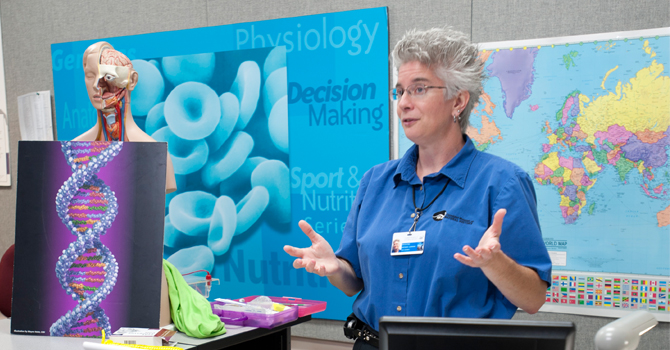Distance learning featured at OMA conference
Lee Gambol, distance learning coordinator and Museum educator, presented a session at the Ohio Museums Association annual conference March 30. The conference, titled “Relevance through Rebirth: Ohio Museums in the 21st Century,” focused on how museums are adapting to the changing landscape of technology and social sharing to keep visitors engaged in order to be thriving cornerstones of the community.
Gambol’s presentation, "Is that REAL?: Digitally Connecting Today's Students with Yesterday's Discoveries,” highlighted some of the Museum’s most popular distance learning programs. It explored the creative way in which the Museum’s educators develop programs that make connections between Museum research and grade-level content standards to offer unique, hands-on learning opportunities to classrooms.

Under Gambol’s supervision, the Museum began developing innovative videoconferencing programs that incorporate the use of kits that are mailed to schools in advance of their programs. Having real objects in the classroom elevates the virtual videoconference session, making it more similar to a real Museum field trip. Gambol showcased several kits and demonstrated how these artifacts, specimens and samples are used by the students during interactive distance learning sessions.
The presentation featured video clips and photos of distance learning sessions. It highlighted programs based on the research of Museum curators and research associates, including Dr. Yohannes Haile-Selassie (Physical Anthropology) on human evolution and the reconstruction of “Lucy,” an ancient human ancestor skeleton cast; Dr. David Saja and Dr. Michael Ryan (Mineralogy/Paleontology) on the relevance of rocks and minerals; and Dr. Darin Croft (Paleobiology) and his research on fossil teeth that provide clues to ancient ecosystems.
The Museum began offering distance learning programs in 2007. The teaching kit-based programs account for one-third of the programs presented each year.
The Museum’s distance learning programs reach between 15,000 and 22,000 students annually, connecting to classrooms in the region, across 48 states and as far away as Mexico, Honduras, Australia, and the United Kingdom. The program received a Pinnacle Award from the Center for Interactive Learning and Collaboration in 2014 and has also been recognized with a Berrien RESA Recommended Award.
For more information regarding the Museum’s distance learning programs, visit cmnh.org/DL